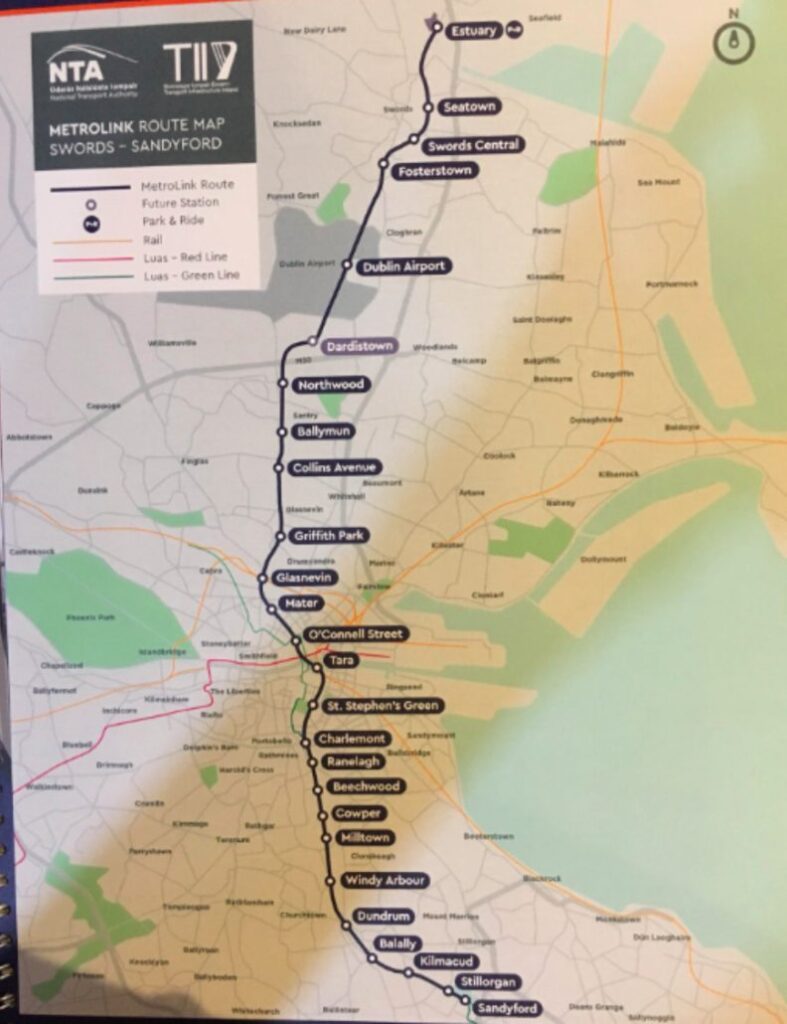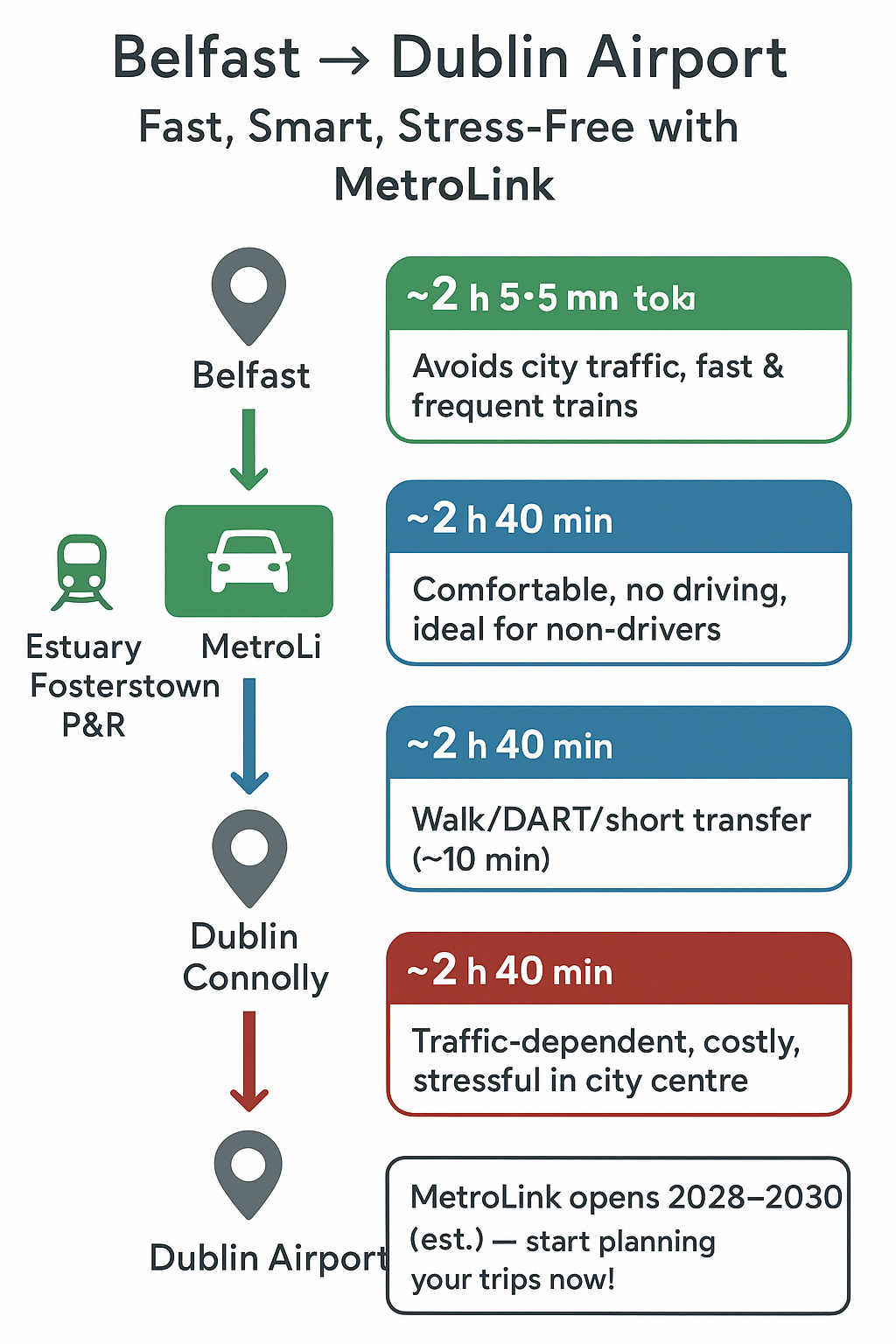- BY Kevin Barry BSc(Hons) MRICS
- POSTED IN Latest News
- WITH 0 COMMENTS
- PERMALINK
- STANDARD POST TYPE


Dublin’s MetroLink is a planned underground metro line connecting Swords to Charlemont in the city, offering several key benefits based on project details and analyses:
- High passenger capacity: It can handle up to 20,000 passengers per hour in each direction, supporting around 53 million journeys annually. 2 sources
- Reduced traffic congestion: By shifting commuters from cars to metro, it will ease road traffic and include 3,000 park-and-ride spaces.
- Environmental improvements: Lower car usage means reduced carbon emissions and better air quality.
- Economic growth: The project is projected to generate €15.6 billion in transport benefits over 60 years, create thousands of jobs during construction and operation, and boost access to economic hubs like Dublin Airport.
- Better connectivity: Seamless integration with existing Luas, bus, and rail services, plus faster links to key areas like the airport and city center.
- Cost and time savings: Reduced travel times and costs for commuters, with added training opportunities for workers.
- Urban development: Enables better access to new housing and development land, supporting population growth in north Dublin.
Overview of Economic Impacts
Dublin’s MetroLink project is projected to deliver substantial economic benefits through improved transport efficiency, reduced congestion, and enhanced connectivity, particularly along the Swords-Dublin Airport-city Centre corridor. However, costs have escalated significantly due to inflation and external factors. Key economic analyses, including cost-benefit assessments, indicate a positive return on investment, with benefits outweighing costs over a 60-year appraisal period. These impacts support broader goals like sustainable urban development and Ireland’s economic competitiveness.
Project Costs
Costs have risen markedly since initial estimates, reflecting inflation, supply chain disruptions (e.g., steel price increases from the Ukraine conflict), and economic pressures like the German recession. The project represents a major capital outlay, potentially straining funding for other infrastructure.
- Capital Expenditure (CapEx): Estimated at €3-4 billion in 2018 prices (excluding VAT), but updated figures show a range of €7.1-12.2 billion in 2021, spiraling to over €23 billion by 2025—a 30% increase in construction costs alone since 2021.
- Operation and Maintenance (O&M) Costs: Approximately €45 million annually, split between €30 million for the core MetroLink line and €15 million for Luas Green Line upgrades.
- Present Value of Costs (PVC): €2.2-2.8 billion (discounted at 5%, in 2011 prices for earlier analysis).
- Historical Context: Originally proposed in 2001 at €2.5 billion; now equivalent to 3.9% of Ireland’s nominal GDP.
- Funding Considerations: Potential sources include €500 million from the European Investment Bank (secured in the 2000s), Ireland’s €13 billion Apple tax windfall, budget surpluses, and EU funding. Delays could add €100-300 million per year due to inflation.
- Opportunity Costs: The project’s scale has “cannibalised” funding for alternatives like Luas extensions across Dublin.
Economic Benefits
Benefits are primarily monetized through transport efficiencies but extend to wider economic effects like productivity gains and urban regeneration. A recent cost-benefit analysis will be repeated post-tendering to confirm value once final costs are set.
- Transport Benefits: Projected at €15.6 billion over 60 years (excluding wider benefits like air quality or safety). Earlier estimates pegged user benefits at €6.8 billion, with 78% from public transport travel time savings (€5.3 billion total).
- Breakdown by user type: Business (€1.2 billion), Commuter (€1.4 billion), Consumer (€4.2 billion).
- Time savings: 1.5 billion hours on public transport (2,070 lifetimes) and 0.6 billion hours on private vehicles (906 lifetimes) over 60 years; e.g., 18 minutes saved from Swords to St. Stephen’s Green.
- Congestion Reduction: Diverts 6.8-12 million private vehicle journeys annually by 2045, up to 360 million by 2050; without MetroLink, congestion could cost €2 billion per year over the next decade.
- Safety: Reduces 15 fatal, 62 serious, and 1,632 slight collisions over 60 years.
- Wider Economic Benefits: €3.1-4.4 billion, including agglomeration effects from business proximity and labor market expansion; supports rezoning of 390 hectares for development, influencing 9,500 hectares within 2.5 km.
- Enhances international connectivity via Dublin Airport (18% of passengers) and boosts trade along the Belfast-Dublin corridor.
- Urban Regeneration: Unlocks growth in Fingal (8.1% population increase since 2011), enabling compact development and reducing urban sprawl.
- Job Creation and Accessibility: Places 175,000 people and 250,000 jobs within walking distance of stations; connects 127 schools, 5 hospitals, and 3 universities. Supports Dublin Airport as Fingal’s largest employer and stimulates innovation/skills growth, though specific job numbers during construction/operation are not quantified in these sources.
Benefit-Cost Ratio (BCR) and Value for Money
- BCR Range: 2.2-3.02 (high value for money, as >2.0 threshold), varying by cost assumptions (e.g., 3.02 at €3 billion CapEx, 2.41 at €4 billion).
- Appraisal Framework: 60-year period (30 years operational + 30 years residual), 5% discount rate, based on Ireland’s Public Spending Code.
Quantitative Projections Table
| Category | Key Figures | Timeframe | Notes |
|---|---|---|---|
| Passenger Demand | 53M in first year, >100M annually over 60 years; 21,000/hour/direction | 60 years | Peak frequency: 90 seconds/train. |
| Time Savings | 2.1B total hours (PT + private vehicles) | 60 years | Equivalent to ~3,000 lifetimes saved from congestion. |
| Vehicle Diversion | 360M car trips avoided | By 2050 | Reduces airport private journeys by 931-3,012/hour. |
| Congestion Cost Avoidance | €2B/year | Next decade | If project not built. |
| Total Transport Benefits | €6.8-15.6B | 60 years | Excludes wider benefits in lower estimate. |
| Wider Economic Benefits | €3.1-4.4B | 60 years | Includes agglomeration. |
Top 10 Proposed Benefits of Dublin MetroLink
- Significantly reduced travel times
- Swords → City Centre in ≈ 25 minutes.
- City Centre → Airport more quickly via a direct connection.
- High frequency & capacity
- Trains every 3 minutes in peak times initially; ability to go to ~90-second intervals as demand rises.
- Capable of carrying up to ~20,000 passengers per hour per direction.
- Large passenger numbers & catchment
- Expected to serve tens of millions of journeys per year (figures like ~50-53 million are used in different documents).
- Some 175,000 people will live within easy walking distance of stations; ~250,000 jobs will be accessible.
- Better connectivity / integration with existing transport network
- Links with Irish Rail, DART / DART+, Luas, buses, BusConnects.
- Direct service to Dublin Airport.
- Encourages modal shift / reduces congestion
- By offering a faster, more reliable alternative to car travel, especially along busy corridors (e.g. Swords-Airport-City Centre).
- Helps relieve pressure on existing public transport modes (buses, trams) and roads.
- Environmental benefits / contributes to sustainability
- Reduced emissions from fewer cars; more energy-efficient transport.
- Aligns with Ireland’s climate goals and sustainable mobility policies.
- Economic benefits
- Benefit-Cost Ratio (BCR) estimated at about 1.4 over 60 years (i.e. benefits exceed costs) under core scenarios.
- Estimated contribution to the economy is ~€13.7 billion over 60 years.
- Supports population growth and urban development
- Helps cater for the rapidly growing population in Fingal and other northern suburbs.
- Enables compact growth and improved accessibility in areas currently under-served.
- Job creation and investment stimulus
- Construction phase will create many direct and indirect jobs.
- Boosts confidence for investment, property development near stations, regeneration of underserved areas.
- Improved accessibility for hospitals, universities, major trip generators
- Key institutions such as Mater Hospital, Rotunda, Dublin City University, Trinity College will be better connected.
- Helps people reach education, healthcare, and other essential services more conveniently.
Top winners and Losers
Winners
- Commuters from Swords and North Dublin
- Massive time savings into the city and airport.
- Direct, frequent service instead of bus-only reliance.
- Dublin Airport (passengers + workers)
- Finally a high-capacity rail link, improving international image and daily access for staff.
- Students & Staff at DCU, Trinity, schools near stations
- Much easier daily journeys, especially from suburbs.
- Healthcare access (Mater, Rotunda, children’s hospitals via transfers)
- Better reach for patients, visitors, and staff.
- Property owners near stations
- Likely uplift in land and rental values due to improved accessibility.
- Businesses in the city centre & near stations
- Larger labour catchment, more customers arriving without cars.
- Environment & climate targets
- Lower emissions by shifting drivers to rail.
- Bus system users
- BusConnects can be reconfigured for feeder roles instead of long slow city runs, improving reliability.
- Construction sector
- Thousands of jobs over the 8–10 year build.
- The wider public transport network
- Relief of pressure on Luas Green Line and crowded bus corridors.
Losers
- Residents & businesses along construction zones
- Noise, dust, traffic disruption for years (O’Connell Street, Glasnevin, Ballymun, etc.).
- Car commuters along the Swords–city corridor
- Less road priority as policy shifts to public transport; may face reduced bus lanes/road space.
- Certain bus routes & drivers
- Some long-standing direct bus services will be truncated or scrapped, reducing one-seat rides.
- Taxpayers wary of mega-project costs
- €9–12bn project risk of overruns; losers if costs spiral.
- Areas not served by MetroLink
- West/Northwest suburbs (Blanchardstown, Lucan, Tallaght) may feel left out — demand but no direct metro.
- Some small businesses along the route
- Reduced footfall during years of street closures.
- Motorists hoping for road upgrades
- Funding priority has shifted heavily towards public transport, so fewer big road schemes.
- Renters near stations
- Risk of gentrification and higher rents due to rising demand around transit nodes.
- Short-haul taxi market
- Airport → city trips could decline as tourists shift to the Metro.
- Other national projects competing for funds
- MetroLink could crowd out investment elsewhere (roads in the west, rural bus improvements, etc.).
